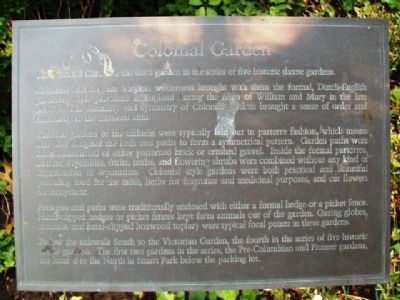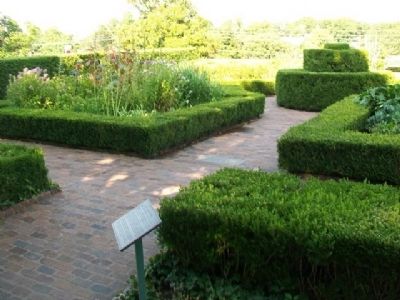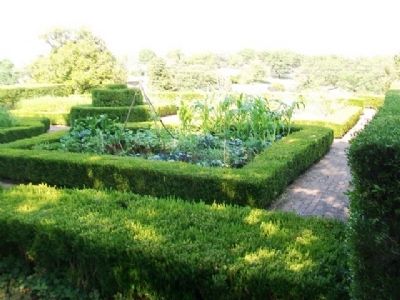Gilcrease Hills in Tulsa in Tulsa County, Oklahoma — The American South (West South Central)
Colonial Garden
The Colonial Garden is the third garden in the series of five historic theme gardens.
Colonists claiming the Virginia wilderness brought with them the formal, Dutch-English gardening style prevalent in England during the reign of William and Mary in the late 1800's [sic - 1600s]. The formality and symmetry of Colonial gardens brought a sense of order and familiarity to the untamed land.
Colonial gardens of the affluent were typically laid out in parterre fashion, which means that they designed the beds and paths to form a symmetrical pattern. Garden paths were often constructed of either patterned brick or crushed gravel. Inside the formal parterres flowers, vegetables, fruits, herbs, and flowering shrubs were combined without any kind of organization or separation. Colonial style gardens were both practical and beautiful providing food for the table, herbs for fragrance and medicinal purposes, and cut flowers for enjoyment.
Parterres and paths were traditionally enclosed with either a formal hedge or a picket fence. Hand-clipped hedges or picket fences kept farm animals out of the garden. Gazing globes, sundials, and hand-clipped boxwood topiary were typical focal points in these gardens.
Follow the sidewalk South to the Victorian Garden, the fourth in the series of five theme gardens. The first two gardens in the series, the Pre-Columbian and Pioneer gardens, are located to the North in Stuart Park below the parking lot.
Erected by Thomas Gilcrease Museum.
Topics. This historical marker is listed in these topic lists: Colonial Era • Entertainment • Horticulture & Forestry • Man-Made Features.
Location. 36° 10.496′ N, 96° 1.236′ W. Marker is in Tulsa, Oklahoma, in Tulsa County. It is in Gilcrease Hills. Marker is on the grounds of the Gilcrease Museum. Touch for map. Marker is at or near this postal address: 1400 North Gilcrease Museum Road, Tulsa OK 74127, United States of America. Touch for directions.
Other nearby markers. At least 8 other markers are within 2 miles of this marker, measured as the crow flies. Simón Bolívar (a few steps from this marker); The Gillies (within shouting distance of this marker); Washington Irving (approx. 1.2 miles away); Indian Memorial (approx. 1.3 miles away); Pioneer Association Picnic Grounds 1921 Memorial (approx. 1.4 miles away); Tulsa's Oldest House (approx. 1.4 miles away); Mt. Zion Baptist Church (approx. 1.9 miles away); The Tulsa Race Riot of 1921 (approx. 1.9 miles away). Touch for a list and map of all markers in Tulsa.
Also see . . .
1. Thomas Gilcrease Institute of American History and Art. Museum homepage (Submitted on August 23, 2013, by William Fischer, Jr. of Scranton, Pennsylvania.)
2. Arboretum and Gardens. Colonial Williamsburg website entry (Submitted on August 23, 2013, by William Fischer, Jr. of Scranton, Pennsylvania.)
3. Creating a Colonial Garden. Penn State Extension website entry (Submitted on August 23, 2013, by William Fischer, Jr. of Scranton, Pennsylvania.)
Credits. This page was last revised on February 16, 2023. It was originally submitted on August 23, 2013, by William Fischer, Jr. of Scranton, Pennsylvania. This page has been viewed 603 times since then and 14 times this year. Photos: 1, 2, 3. submitted on August 23, 2013, by William Fischer, Jr. of Scranton, Pennsylvania.


